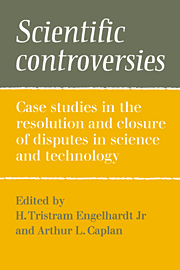 Scientific Controversies
Scientific Controversies Book contents
- Frontmatter
- Contents
- Preface
- List of contributors
- Introduction: Patterns of controversy and closure: the interplay of knowledge, values, and political forces
- PART I THEORETICAL PERSPECTIVES
- PART II CONTEMPORARY CASE STUDIES
- 12 Resolution of the Laetrile controversy: past attempts and future prospects
- 13 Federal regulation of Laetrile
- 14 Quasi libertarianism and the Laetrile controversy
- 15 Judicial deflection of scientific questions: pushing the Laetrile controversy toward medical closure
- 16 Politics, science, and the problem of psychiatric nomenclature: a case study of the American Psychiatric Association referendum on homosexuality
- 17 The diagnostic status of homosexuality in DSM-III: a reformulation of the issues
- 18 On arriving at the American Psychiatric Association decision on homosexuality
- 19 Values in the debate over workplace safety and health: the rancorous rhetoric about regulation
- 20 The successful experiment that failed
- 21 The power of efficiency: balancing benefits and costs in regulating occupational exposure to toxic substances
- 22 Closure in occupational safety and health: the benzene and cotton dust decisions
- 23 Nuclear fear: a history and an experiment
- 24 Closure and controversy: Three Mile Island
- 25 Understanding the nuclear power controversy
- PART III CONTROVERSY, CLOSURE, AND THE PUBLIC
- Author index
- Subject index
24 - Closure and controversy: Three Mile Island
Published online by Cambridge University Press: 03 February 2010
- Frontmatter
- Contents
- Preface
- List of contributors
- Introduction: Patterns of controversy and closure: the interplay of knowledge, values, and political forces
- PART I THEORETICAL PERSPECTIVES
- PART II CONTEMPORARY CASE STUDIES
- 12 Resolution of the Laetrile controversy: past attempts and future prospects
- 13 Federal regulation of Laetrile
- 14 Quasi libertarianism and the Laetrile controversy
- 15 Judicial deflection of scientific questions: pushing the Laetrile controversy toward medical closure
- 16 Politics, science, and the problem of psychiatric nomenclature: a case study of the American Psychiatric Association referendum on homosexuality
- 17 The diagnostic status of homosexuality in DSM-III: a reformulation of the issues
- 18 On arriving at the American Psychiatric Association decision on homosexuality
- 19 Values in the debate over workplace safety and health: the rancorous rhetoric about regulation
- 20 The successful experiment that failed
- 21 The power of efficiency: balancing benefits and costs in regulating occupational exposure to toxic substances
- 22 Closure in occupational safety and health: the benzene and cotton dust decisions
- 23 Nuclear fear: a history and an experiment
- 24 Closure and controversy: Three Mile Island
- 25 Understanding the nuclear power controversy
- PART III CONTROVERSY, CLOSURE, AND THE PUBLIC
- Author index
- Subject index
Summary
Closure through circumscription
The experiences of the President's Commission on the accident at Three Mile Island suggest that closure on a controversial matter might be reached by narrowing the terms of the debate. I propose that the final report of the commission received rather wide support because it dealt with a limited and empirically based problem: What had taken place at Three Mile Island (TMI) Unit 2 and its environs beginning March 28, 1979. Had the document addressed the broader matter of the safety of nuclear energy, far fewer of its readers would have accepted it as decisive or significant. My purpose here is to trace the processes through which a limited definition of the problem emerged and to reflect on the reasons for and consequences of what I would term closure through circumscription.
Background to the formation of the commission
On April 11, 1979, President Jimmy Carter signed an executive order creating the President's Commission on the Accident at Three Mile Island. The order read as follows:
The Commission shall conduct a comprehensive study and investigation of the recent accident involving the nuclear power facility on Three Mile Island in Pennsylvania. The study and investigation shall include:
(a) a technical assessment of the events and their causes;
(b) an analysis of the role of the managing utility;
(c) an assessment of the emergency preparedness and response of the Nuclear Regulatory Commission and other federal, state and local authorities;
(d) an evaluation of the Nuclear Regulatory Commission's licensing, inspection, operation and enforcement procedures as applied to this facility; and
(e) an assessment of how the public's right to information concerning the events at Three Mile Island was served and of the steps which should be taken during similar emergencies to provide the public with accurate, comprehensible and timely information.
- Type
- Chapter
- Information
- Scientific ControversiesCase Studies in the Resolution and Closure of Disputes in Science and Technology, pp. 551 - 566Publisher: Cambridge University PressPrint publication year: 1987
